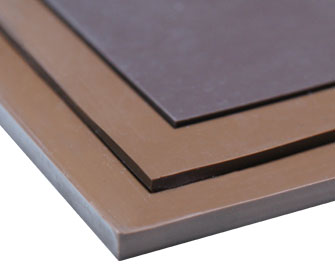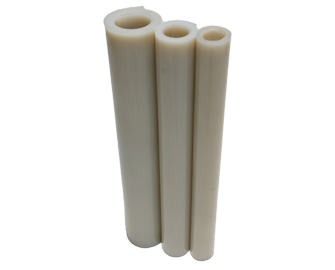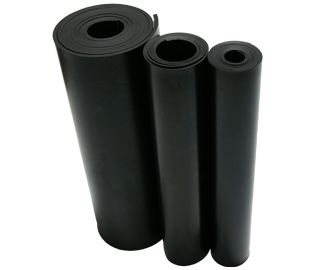|
|
A silicone rubber sheet is commonly used in abrasive applications in industrial, commercial, and residential settings due to silicone’s excellent chemical and physical properties. Silicone is a synthetic rubber variation that is best known for its superior operating temperature range that allows it to remain intact and reliable in both extremely high and low temperatures. Heat resistant silicone is commonly used to create silicone rubber parts for industrial applications. PVC, vs silicone, does not retain the same durability as silicone and will be damaged by most factors that will not affect silicone. Silicone, unlike PVC, is also a versatile indoor/outdoor rubber material that can be used outdoors without being damaged by environmental factors. Silicone rolls are durable and reliable materials that are used to create durable rubber products for any setting.
Is Silicone a Form of Rubber?
Silicone is a form of rubber that is made of silicon, carbon, hydrogen, and oxygen. A silicone rubber sheet is a synthetic rubber material that is made through a blend of chemical compounds. Case in point, “Silicone is a lab-made material that consists of several different chemicals, including silicone (a naturally occurring element), oxygen, carbon, and hydrogen” (healthline.com). These chemical elements combine to form a unique synthetic rubber material that offers a wide range of applications. As an elastomer, silicone rubber sheet is highly flexible and retains a high tear strength, allowing it to stretch out without worry of tearing in an application. Flexibility is an important factor to have in silicone rubber parts, especially in industrial settings, to provide safe applications. Unlike most rubber variations, including synthetic rubbers, silicone rolls retain unique properties that allow it to remain flexible and intact in the face of abrasive factors. Silicone rubber sheet is highly durable and offers numerous long-lasting properties, such as heat resistance, chemical stability, electrical insulation, abrasion resistance, and resistance to damaging environmental factors, allowing it to be a versatile material (omnexus.specialchem.com). In addition to these properties, a silicone rubber sheet will also remain flexible in extremely low temperatures, further increasing silicone’s versatility.
Due to these durable properties of a silicone rubber sheet, silicone rubber parts can be used for general purpose rubber applications in any setting, whether it be residential, commercial, or industrial. Heat resistant silicone is commonly used in industrial settings as gaskets and seals due to its wide operating temperature range of -103 to +500 degrees Fahrenheit. Along with its high temperature resistance, its low temperature range of -103 degrees Fahrenheit allows it to remain flexible in extremely low temperatures and resist breakage caused by embrittlement. Thanks to its operating temperature range, a silicone rubber sheet is commonly used to create silicone weatherstripping as temperatures are constantly changing according to the weather. In addition, in industrial settings, its wide operating temperature range as well as the chemical resistance of silicone allow it to provide reliable applications when used to create industrial seals and gaskets. Because industrial settings can expose rubber parts to caustic chemicals and a wide range of temperatures, a silicone rubber sheet is the ideal material for industrial settings.

|

|
(a)Is Silicone Same as PVC?
Silicone is not the same as PVC because silicone is a rubber while PVC is a plastic. A silicone rubber sheet is considered an elastomer due to its excellent flexibility and pliability. On the other hand, PVC, or polyvinyl chloride, is a high strength thermoplastic material… It is the world's third-most widely produced synthetic plastic polymer” (omnexus.specialchem.com). PVC is a highly durable material that retains excellent tear strength and abrasion resistance as well as excellent chemical resistance; however, PVC, vs silicone, cannot withstand extreme temperatures. For instance, PVC is commonly used in industrial and commercial settings where it can be exposed to both extreme high and low temperatures. Due to its properties, heat resistant silicone can provide more durable and reliable applications in industrial settings. A silicone rubber sheet can stay intact and flexible when exposed to extreme high and low temperatures whereas PVC is highly susceptible to melting in high temperatures and becoming hard and brittle in low temperatures. PVC, vs silicone, is not as flexible or shock absorbent, making it not as suitable for seals and gaskets but better for use as abrasion resistant surfacing. Contrastingly, a silicone rubber sheet can provide reliable shock absorption and flexibility, making it the perfect material for use as industrial seals and gaskets. In addition, PVC, vs silicone, cannot be used in outdoor settings as it can be severely damaged by harmful environmental factors, such as UV rays, ozone, oxygen, and wet weather conditions; however, silicone rolls can remain intact in the face of these factors, making silicone weatherstripping reliable products in any setting.

|

|
PVC is a plastic material that retains high tear strength and excellent abrasion resistance. Contrastingly, silicone rolls are synthetic rubber materials that retain excellent flexibility and pliability. Despite its durable physical properties, PVC, vs silicone, cannot withstand extremely high or low temperatures without melting or becoming brittle and breaking. A silicone rubber sheet, on the other hand, retains a wide operating temperature, allowing it to remain intact and flexible in the face of extreme temperatures. Additionally, due to its flexibility, silicone rubber parts will provide excellent protective applications against impacts and abrasions. Furthermore, silicone can be used both indoors and outdoors thanks to its resistance against UV rays, ozone, oxygen, and wet weather. Overall, a silicone rubber sheet can provide reliable applications in the presence of abrasive physical and chemical factors. PVC vs Silicone
|
|
|